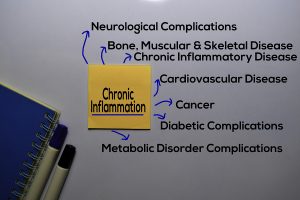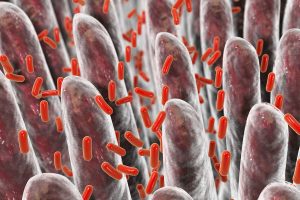Dr. James LaValle gave a presentation about changes of metabolism by inflammation in Las Vegas. I listened to this lecture on Dec. 15, 2020. The 27th Annual World Congress on Anti-Aging Medicine in Las Vegas took place from Dec. 13 to 15th, 2019. His original title was: “Innovations in Metabolism and Metaflammation”. This talk was complex and as a result it may not be easy reading. But it shows how various factors can affect our metabolism and our life expectancy.
In the first place he understands “metabolism” as all of the chemical reactions together that make you feel the way you feel today. In the same way metabolism is the chemistry that drives you toward future health. It is equally important to note that disregulation of your metabolism occurs from global metabolic inflammatory signalling. As has been noted he called this “metaflammation” (inflammation affecting your metabolism).
Dr. LaValle said that understanding disruptors of your metabolism can lead to renew your health on a cellular level. The key to achieve this is to remove inflammatory signals.
Factors that accelerate aging and damage your metabolism
It is important to realize that several factors interfere with the normal aging process. Oxidative stress and inflammation are major factors. But hormone disbalance and increased blood sugar values and insulin resistance can also contribute to accelerated aging and damage your metabolism. Certainly, with a disturbance of the immune balance, autoimmune reactions can take place, which also does not help. In addition, pollutants from the environment derange the metabolism due to heavy metals that block important enzymatic reactions. In the minority there are also genetic factors that can interfere with a normal metabolism.
Many of the metabolic changes can lead to chronic inflammation. One source of inflammation can be lipopolysaccharides that stimulate the immune system to start an inflammatory process.
Many conditions are associated with inflammation such as diabetes, obesity, stress, the SAD diet (standard American diet), and liver or kidney damage.
How Metaflammation is developing
Metaflammation can start in the gut with microbiota alterations. The wrong types of bacteria can release lipopolysaccharides, and low grade endotoxemia develops. With obesity inflammatory kinins start circulating in the body. Stress can activate inflammatory substances in the brain and the rest of the body. Major contributors to inflammation in the body come from faulty diets. The Western diet contains too much sugar and refined carbs; it is too high in trans fats and saturated fats. It contains too many artificial additives, preservatives, salt, sweeteners and dyes. And it is too low in nutrients, complex carbs and fiber.
More problems with metaflammation
Kidney and liver illness can contribute to metaflammation. Several diseases come from chronic inflammation, like cardiovascular disease, type 2 diabetes, chronic kidney disease, depression, cancer, dementia, osteoporosis and anemia. Metaflammation alters the methylation patterns, which can slow down your metabolism. Increased blood lipids and chronic inflammation of the blood vessels lead to cardiovascular problems. The liver and kidneys are the major detoxification organs, and their disease leads to more metaflammation. Metaflammation also leads to hormone disbalances, sleep disorders and dysfunction of the immune system. The brain reacts to metaflammation with cognitive dysfunction and mood disorders. Muscle loss (sarcopenia) is another issue, so is osteoporosis. Finally, chronic metaflammation can cause cancer.
Major causes of metaflammation
The three major causes of metaflammation are changes of the gut microbiome, obesity and chronic stress. When the gut bacteria change because of a Western diet, the wrong bacteria release lipopolysaccharides that are absorbed into the blood. The gut barrier is breaking down and a low grade endotoxemia develops. With obesity adipokines, which are inflammatory substances secreted by the fatty tissue, circulate in the blood. Chronic stress activates inflammation in the brain and in the body.
Two major conditions are common with metaflammation: hyperlipidemia (high fat levels in the blood) and hyperglycemia. Both of these conditions change the metabolism and lead to cardiovascular disease (hyperlipidemia) or to type 2 diabetes (hyperglycemia). Both of these metabolic changes lead to one or more of the conditions mentioned above, accelerate the aging process and lead to premature deaths.
Interaction of various organ systems can cause metaflammation
Dr. LaValle stated that it is vital that your hormones stay balanced. With chronic stress cortisol production is high. This causes increased insulin production, reduced thyroid hormone and lowered serotonin and melatonin production in the brain. It also leads to autoimmune antibodies from the immune system and decreased DHEA production in the adrenal glands. In addition, growth hormone production and gonadotropin hormones are slowing down. We already heard that cortisol levels are up. The end result of these hormone changes is that the blood pressure is up and abdominal visceral obesity develops. The brain shows cognitive decline, with memory loss as a result. The bones show osteopenia, osteoporosis and fractures. The muscles shrink due to sarcopenia, frailty is very common. Heart attacks and strokes will develop after many years. The immune system is weak and infections may flare up rapidly. There are also higher death rates with flus.
Other mechanism for pathological changes with hormone disbalances
When Insulin is elevated, inflammatory markers are found in the bloodstream. This elevates the C-reactive protein and leads to damage of the lining of the blood vessels in the body. A combination of insulin resistance and enhanced atherosclerosis increases the danger for heart attacks or strokes significantly.
There is a triangle interaction between the thyroid, the pancreas and the adrenals. Normally the following occurs with normal function. The thyroid increases the metabolism, protein synthesis and the activity of the central nervous system. The pancreas through insulin converts glucose to glycogen in the liver. It also facilitates glucose uptake by body cells. The adrenal hormones are anti-inflammatory, regulate protein, carbohydrate and lipid metabolism and contribute to energy production.
Change of thyroid/pancreas/adrenals triangle when cortisol is elevated
When cortisol is elevated the balance of the thyroid/pancreas/adrenals’ triangle is severely disturbed. Cortisol is high, the T4 to T3 conversion is limited and, in the brain, there is hippocampus atrophy with memory loss and brain fog. The immune system will change with production of inflammatory kinins (IL-6 and TNF alpha). Insulin sensitivity is down, sugar craving up and weight gain develops (central obesity).
Change of thyroid/pancreas/adrenals triangle when the thyroid is depressed
The thyroid activity can be lower because of autoimmune antibodies (Hashimoto’s disease) or because of hypothyroidism developing in older age. This leads to decreased pregnenolone synthesis from cholesterol. As pregnenolone is the precursor for all the steroid hormones, the metabolism slows down profoundly. Mentally there is depressed cognition, memory and mood. The cardiovascular system shows reduced function. In the gut there is reduced gastric motility. The mitochondria, which are tiny energy packages in each cell, are reduced in number, which causes a loss of energy. There is increased oxidative stress, increased lactic acid production and decreased insulin sensitivity.
Cardiovascular disease not just a matter of high cholesterol
Dr. LaValle stressed that a heart attack or stroke is not just a matter of elevated cholesterol. Instead we are looking at a complicated interaction between hypothyroidism, diabetic constellation and inflammatory gut condition. The inflammatory leaky gut syndrome causes autoimmune macrophages and Hashimoto’s disease. The end result is hypothyroidism. The inflammatory kinins (TNF-alpha, IL-6) affect the lining of the blood vessels, which facilitates the development of strokes and heart attacks. You see from this that cardiovascular disease development is a multifactorial process.
Microbiome disruption from drugs
Drugs affecting the intestinal flora are antibiotics, corticosteroids, opioids, antipsychotics, statins, acid suppressing drugs like protein pump inhibitors (PPI’s) and H2-blockers. Other factors are: high sugar intake, pesticides in food, bactericidal chemicals in drinking water, metformin, heavy metals and alcohol overconsumption. Chronic stomach infection with H. pylori, stress and allergies can also interfere with the gut microbiome.
The microbiome disruption affects all facets of metabolism. This means that there can be inhibition of nutrient absorption and this may affect the gut/immune/brain axis. There are negative effects on blood glucose levels and insulin resistance. A disturbance of the sleep pattern may be present. A significant effect on the hormonal balance can occur (thyroid hormones, sex hormones and appetite related hormones). When liver and kidney functions slow down, there is interference of body detoxification.
Dr. LaValle talked more about details regarding the gut-brain-immune pathology. I will not comment on this any further.
Conclusion
Dr. LaValle gave an overview in a lecture regarding changes of metabolism by inflammation. This took place at the 27th Annual World Congress on Anti-Aging Medicine in Las Vegas from Dec. 13 to 15th, 2019.
This article is complex and contains a lot of detail, but there is one simple truth: oxidative stress and inflammation are major factors that influence our health on many parameters and lead to a list of illnesses. They lead to hormone disbalance and increased blood sugars and insulin resistance, which can also contribute to accelerated aging and damage of your metabolism. Dr. LaValle explained how high cortisol from chronic stress can lead to low thyroid hormones and in the brain, there is hippocampus atrophy with memory loss and brain fog. With alterations of the immune system there is production of inflammatory kinins (IL-6 and TNF alpha). Insulin sensitivity is down, sugar craving up and weight gain develops (central obesity). It does not stop there! We put our hope in medications, but the sad truth is that there are
Drugs that change the gut biome
Many drugs that are common also change the gut biome with resulting increased permeability of the gut wall (leaky gut syndrome). This overstimulates the immune system and leads to autoimmune diseases like Crohn’s disease and rheumatoid arthritis. Whenever there is an injury to the gut barrier, the blood brain barrier is following suit. This is how brain disease can develop as a result of a change in the gut biome. Impaired cognition, memory and mood can result from this. Alzheimer’s disease is one of the worst conditions that may be related to a combination of gut inflammation, chronic stress and inflammatory kinins.








